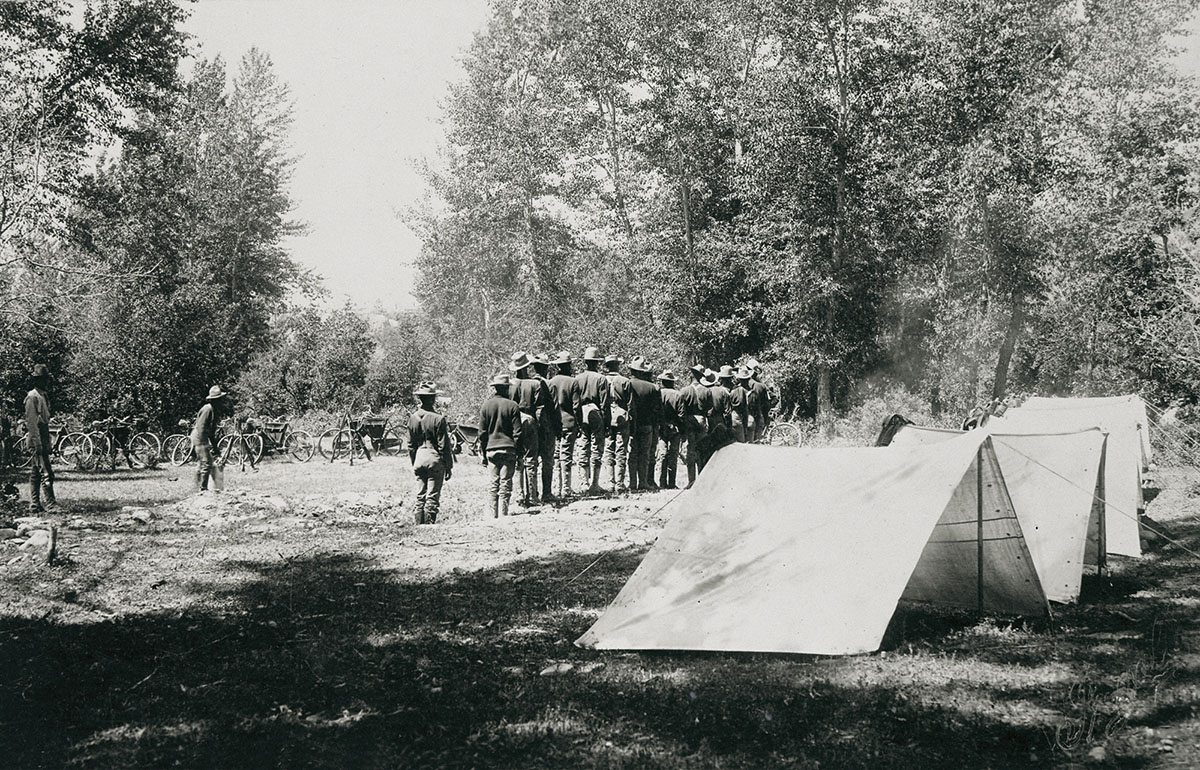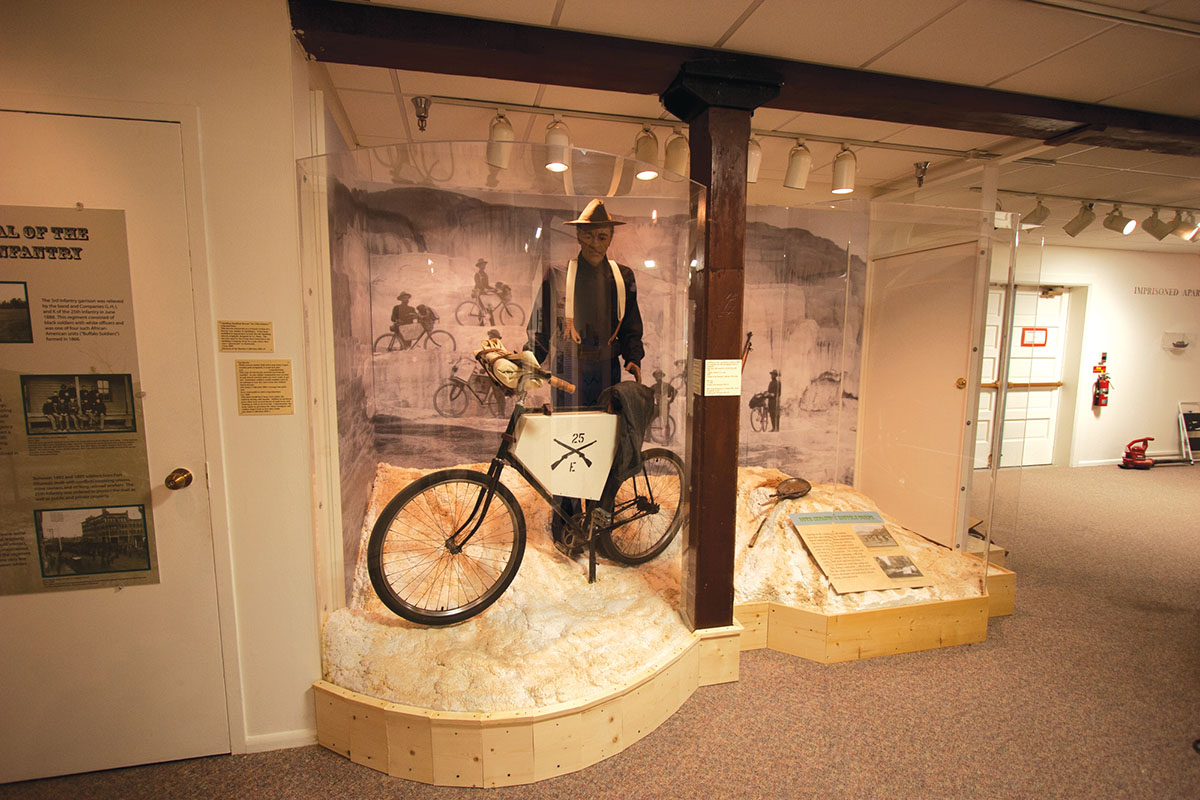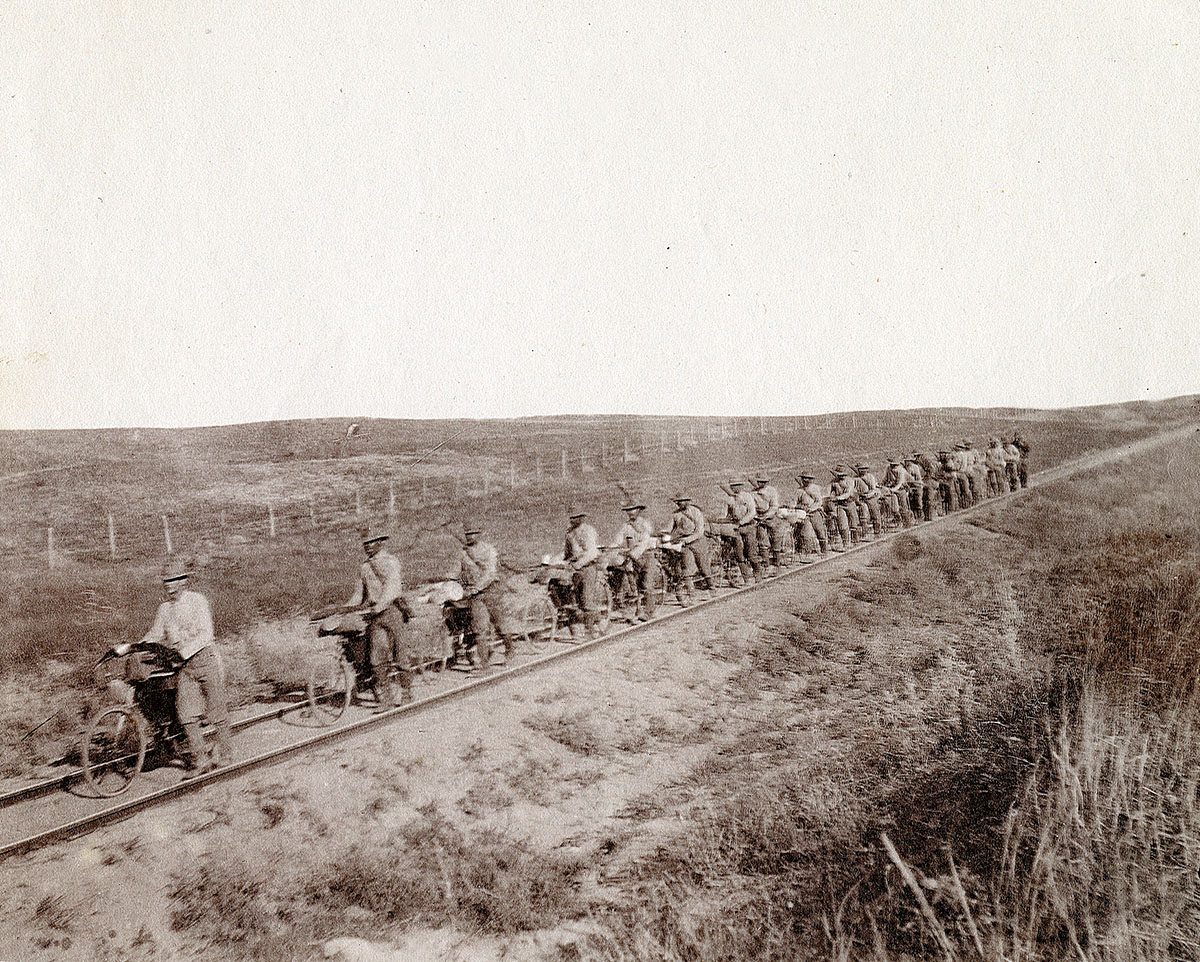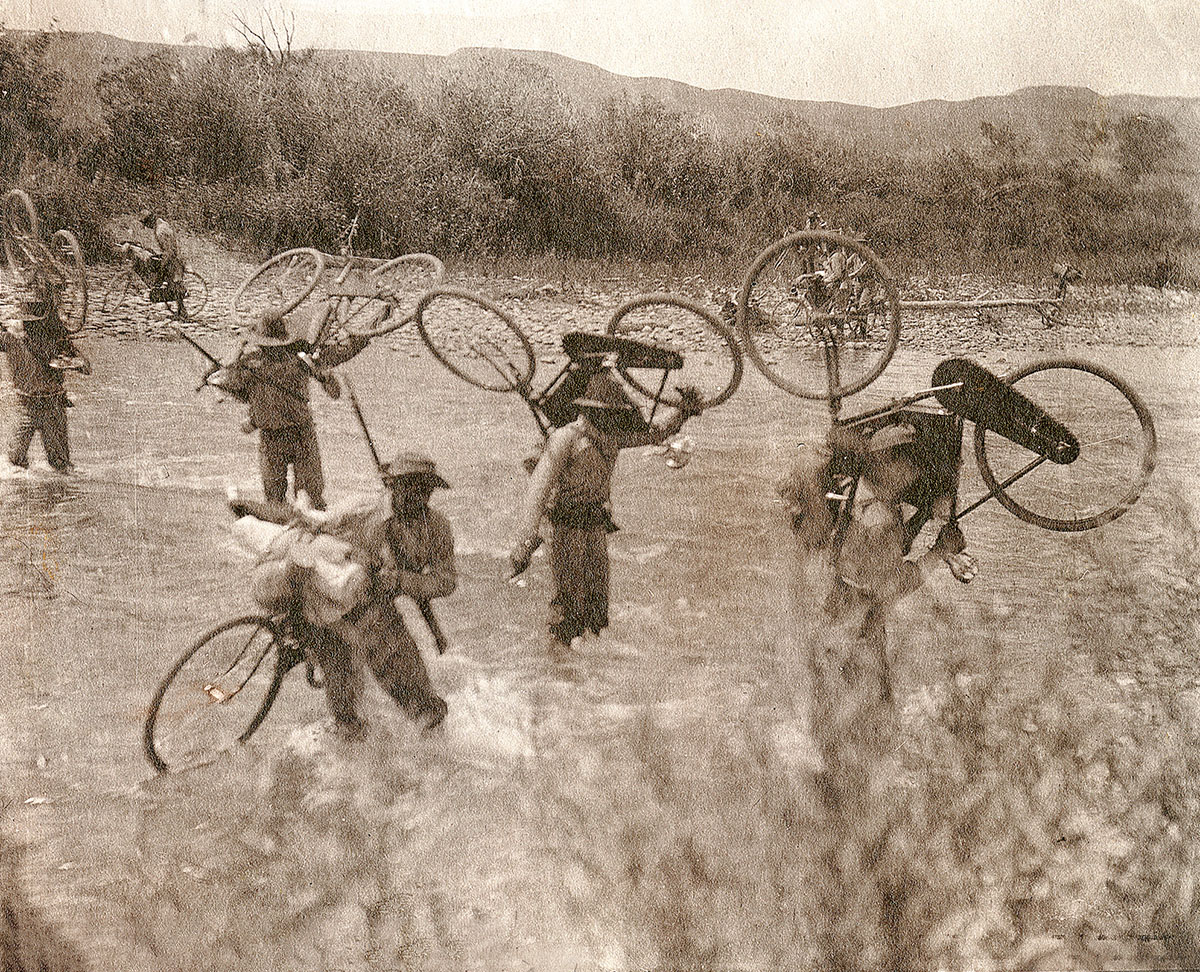The Bicycling Buffalo Soldiers
This article originally appeared in the May 2011 issue of Adventure Cyclist.
In 1974, a young Black woman in New Jersey named Miriam Martin decided to head west to Montana. Martin had been recruited to join the African-American Studies program at the University of Montana, established in 1968 by Professor Ulysses Doss. The program at UM was only the third like it in the U.S. at the time, and the first to be established outside of California.
Doss himself had been involved in the civil rights movement of the 1960s, working with Dr. Martin Luther King, Jr. to integrate residential neighborhoods in the Chicago area. After King’s assassination in April 1968, Doss, struggling to contain rioting in the Black community in Chicago and dealing with his own grief over King’s death, had taken a rare vacation to Missoula, where a friend had a ministry.
A few public lectures led to an invitation to teach in the humanities program at the University of Montana, and 25 years later in 1993, Doss retired from UM, leaving behind the legacy of his African-American Studies program.
“Here I was, a little girl from a small neighborhood, Black, and from a close-knit community, and I ventured out to Missoula to attend the University of Montana,” Martin recalled.
But that wasn’t all Martin did.
“I don’t know. I was so crazy and adventurous that I went on a 1,900-mile bicycle trip as well,” Martin said.
The trip Martin went on with seven other students in the African-American Studies program began in Missoula and ended in St. Louis, retracing the route of the remarkable journey taken by 20 Black soldiers of the 25th Infantry Bicycle Corps, led by James A. Moss, a white lieutenant, and accompanied by assistant surgeon J. M. Kennedy, also white.
The Buffalo Soldiers, as the Black infantrymen were known, left Fort Missoula at 5:30 AM on June 14, 1897, riding donated Spalding bicycles. They arrived in St. Louis 34 days later on July 24 to a grand reception in Forest Park, equivalent in that city to New York’s Central Park. The Buffalo Soldiers had averaged nearly 56 miles per day over the most primitive roads imaginable, sometimes resorting to bumping over railroad tracks through soaring mountains lashed by rain, over the alkali deserts of the Badlands, and into the furnace-like heat of the Midwest in summer.

The entire enterprise was pushed on the reluctant army brass by Lieutenant Moss, who was required to pull it off without expending any army money. Moss made it happen because he wanted to demonstrate the superiority of bicycles to horses for transporting soldiers. Lucky for Moss, Major General Nelson A. Miles, a titanic figure from both the Civil War and the Indian Wars, shared his fascination with the potential of the bicycle as a military vehicle, and he intervened at key moments to keep Moss’s dream alive.
In the end, however, the army let the experiment fizzle, declining to authorize Moss to organize another test of the bicycle’s effectiveness by mounting a ride from Fort Missoula to San Francisco after the success of the ride to St. Louis. The army brass coolly replied that everything that needed to be known about using bicycles in the military was already known and there was no need for further investigation. Or, as they understood reading between the lines, there was no future for a bicycle-mounted infantry.
“When we were students out there at UM and studying about the 25th Infantry’s historic feat, we were so proud to learn about the African-Americans who were there before us,” Martin said. “Although they were the first, we still felt like pioneers, especially in reenacting this experiment. We felt we had a purpose. We were coming from all parts of the country, learning about our connection with Montana. We were pioneers, just like they were.”
Martin, who had no previous cycling experience, said the most difficult part of the journey of about 30 days was getting adjusted to her bike saddle, a familiar complaint among novice cyclists. She said the ride of nearly 40 years ago helped shape the woman she is today.
“I could have said I wanted to go home and would have been taken to the next town or city and provided transportation there,” Martin said. “But my mindset was that this was something we had to do and that I had to do for myself. I wasn’t going to quit. There was no turning back. The only option was to keep going.”
Martin still remembers the remarkable western skies and the “gorgeous mountains.” When she returned home to New Jersey after graduating from the University of Montana and started working, she decided she wasn’t happy with her job and went back to get her teaching certification, later adding a master’s degree in technology and computers.
Today she is a technology coordinator, helping teachers incorporate technology in their classrooms in the public school system in Orange, New Jersey.
“You can’t stop, that’s what I got from that experience out there,” Martin said.
The Buffalo Soldiers also inspired Mike Higgins, a middle-school history teacher in tiny Deaver, Wyoming, about 40 miles north of Cody. Higgins admitted the ride of the 25th has become something of an obsession for him. His interest in the Buffalo Soldiers began with a two-page story from the children’s magazine Highlights. His brother, a “bicycle-tour kind of guy,” had sent it to him more than a decade before.

Unfortunately, none of the original Spalding bikes are in existence today.
Higgins’s brother died of cancer in 1997. “Somehow that story was linked in some kind of crazy way to my brother,” Higgins said. “I just started thinking about it.”
He began to research the topic. Higgins brought his skills as a history teacher to his growing interest in the epic ride of the 25th, looking for primary source materials and piecing together the details of their route, poring through dozens of contemporary newspaper articles and letters left behind by Moss and others. (You can find the fruits of Higgins’s research here.)
“I thought that, I need to do the trip to try to understand it more,” Higgins said. “I spent five years researching it. I had binders full of stuff.”
In 2009, Higgins decided to follow in the Buffalo Soldiers’ wheel tracks.
“I was going self-contained, and I didn’t really have a plan,” Higgins said. “I didn’t know how I was going to get back when I got to St. Louis. A daughter was going to pick me up, and that fell apart. I decided to just go for it.”
Higgins’s 73-year-old mother, a history buff herself, offered to drive sag, but Higgins turned her down.
“I said, ‘Mom, I’m 48, people bicycle tour all the time,’” Higgins said.
But things did not go well. Leaving Missoula in June, Higgins was hit with snow.
“I was ready to get wet, but not for freezing temperatures,” he said.
South of Townsend, Montana, Higgins knew the Bicycle Corps had gone through a canyon that today’s highway skirts.
“So I went into that canyon,” Higgins said. “It was about 7:00 PM. To make a long story short, I ended up walking on the railroad tracks for miles. It was 11:00 at night, and I thought I was going to get arrested or be hit by a train.”
On one side of Higgins was a river, on the other an electric fence to keep animals from getting on the tracks. Emerging from the canyon into the pitch black night, Higgins kept walking with his bike on the railroad track, an experience the Corps shared more than once.
By the time he got to Bozeman a few days later, Higgins said he was “practically hypothermic,” and in Livingston, he stopped to rethink what he was doing.
“I thought, ‘This is not working,’” Higgins said.
He abandoned the ride.
“I was really upset that I quit,” Higgins said. “I was depressed because I had thought about this for years and years. My mother saved my butt.”
In 2010, enter Mom, now 74 years old and still willing to drive sag.
“When I succeeded in my attempt, my mom came with me,” Higgins said. “It worked out really well.”
With his mother driving his truck, Higgins rode out of Missoula on May 27 and finished in St. Louis 28 days later on June 24. Because his mother came along, he was able to do the research he wanted to do along the route. In Missouri, for example, Higgins wanted to visit the state archives in Columbia, so he was able to jump in the truck and drive there, then get back to the route the next day to continue his ride. He wouldn’t have had that kind of flexibility if he had been riding self-contained.
He also got to spend precious time with his mother.

“My mom is 74,” he said. “How much more time will I have with her? That was providential, and it gave us a lot of time together.”
Arriving in Forest Park, Higgins was moved to see two Black women sitting in chairs and talking. He had seen a photograph from the archives of a St. Louis newspaper of two Buffalo Soldiers sitting in chairs and visiting with each other at the end of their long ride, and they were occupying the same spot.
“That was poetic,” Higgins said. “To me there are so many connections in this world and this life.”
Higgins tried to trace what had happened to as many of the Buffalo Soldiers (and, to the white soldiers who led them, Moss and Kennedy) as he could. Kennedy went on to become an Assistant Surgeon General for the U.S. federal government. Higgins was able to find Kennedy’s living descendants and they sent him an account that either Kennedy or one of his children had written about his life. It included an account of the Bicycle Corps.
Other stories were tragic. Sergeant Mingo Sanders, a highly decorated soldier who served in the Spanish-American War in Cuba and the Philippines, in many ways was the glue that held the Bicycle Corps together. He was sent to Brownsville, Texas, in 1906, along with a contingent of Buffalo Soldiers, in spite of warnings from white officers that sending Black soldiers to Texas was asking for trouble.
“The army didn’t listen and sent these guys down to Brownsville,” Higgins said. “Two weeks later, that town got shot up and everybody blamed the Black guys.”
Despite their protestations of innocence, proof that their weapons had not been fired, and an absence of eyewitnesses, the Black soldiers were thrown out of the army. They were not dishonorably discharged, but discharged without honor, a little-used administrative device employed by President Theodore Roosevelt to drum the Buffalo Soldiers out of the army without a public hearing.
“Sanders was months away from retiring,” Higgins said. “They took his pension and everything. It was a really sad incident. He had diabetes and died tragically after they amputated his legs.”
Sanders appealed to Roosevelt before he died, asking for reinstatement in the army. He explained that his savings were gone and his wife was sick, but his request fell on deaf ears, according to an account in Iron Riders, George Niels Sorensen’s book about the 25th.
Moss, the leader and visionary, made a fortune writing books on subjects such as flag etiquette, said Higgins, retiring from the army to enjoy his money. Yet he too died tragically. He was killed in a traffic accident in New York City in 1941 at the age of 68.
Sorensen’s book is the definitive account available of the 25th’s epic ride. Interest in the bicycle as a military vehicle peaked toward the end of the 19th century, on the heels of a social revolution centered on the bicycle that spawned everything from six-day races in New York attended by thousands of people to popular songs like “A Bicycle Built for Two.”
As might be expected, European militaries were ahead of their American counterparts in terms of using bikes. But Moss and his benefactor, General Miles, were determined to close that gap. Moss’s original letter formally requesting permission to organize a bicycle corps was dated April 13, 1896.
As Sorensen wrote, Moss said he wanted to make a number of experiments during the coming summer and fall using the bicycle as a practical machine for military purposes.
“With this end in view, I am very desirous of organizing at this post a detachment of cycle infantry. I have taken great interest in the subject as treated in this country and abroad, and am especially anxious to give the matter a thorough test in the mountainous country hereabout, where no experiments have ever been made. The main roads and prairie trails are fine for bicycles and I am very anxious to test the practicability of the bicycle in going over some of our mountain trails,” wrote Moss.

He may have been a bit on the optimistic side concerning just how “fine” the roads and prairie trails were for cycling. After a series of group rides covering 15 to 40 miles a day, Moss and his bicycle corps were ready for their first major outing — to Lake McDonald near St. Ignatius, north of Missoula.
Seven riders made the trip to Lake McDonald, including Moss, their packed bicycles weighing on average 76.2 pounds. Moss himself, who kept meticulous records, only weighed 135 pounds, and the average weight of the riders was 155.7 pounds. The list of rations for the trip included 35 pounds of flour, 20 pounds of bacon, and three pounds of lard. All told, provisions totaled 120 pounds to be split among the seven men.
The group left Fort Missoula at 6:20 AM on August 6, 1896, reaching Missoula in 25 minutes. (Today, of course, the city of Missoula surrounds the old fort.) In town the soldiers took to the sidewalks because the streets were so muddy. Over a six-mile stretch about 12 miles out of Missoula, they were forced to dismount at least 20 times to navigate around swampy mud pits and fallen trees, Sorensen wrote.
Still, the men covered 51 miles that first day, reaching Mission Creek, a half-mile above St. Ignatius Mission, at 7:30 PM. The next day, the riders continued to be plagued by gumbo mud and punctures, at one point stopping the entire party while 12 loose tires were cemented back on the wooden rims that the bikes used. Although the men walked rather than rode their bikes much of the way, Moss wrote an official report hailing their efforts and requested permission for a ride to Yellowstone, the nation’s first national park, established in 1872.
For the ride to Yellowstone, there would be nine riders, including Moss, again riding bikes weighing an average of nearly 80 pounds. The ride to Yellowstone began on August 15 at 6:05 in the morning. Once again, thick mud, headwinds, and dusty tracks awaited the intrepid riders. On the way back from Yellowstone, which was already beginning to see more and more cyclists, the bicycle corps had a remarkable encounter.
Outside of Bozeman, two of the riders collided, shattering the wooden rim of one of the front wheels.
“The rider carried his damaged bicycle the rest of the way into camp, and the men were trying to figure out a way to improvise a repair when a bicycle tramp appeared,” wrote Sorensen. “The tramp explained that he had been riding around the West, covering Montana, Wyoming, Idaho, Nevada, and other states. Always in search of work, he saw the broken bicycle as an opportunity. Claiming to be an excellent bicycle mechanic, he offered, for three dollars, to ride the six miles into Bozeman, locate a new rim, and have the cycle fixed by six o’clock the next morning. The soldiers agreed, and Wandering Willie disappeared into the night.”
What Willie went through to collect his three dollars was remarkable. He found the only bike shop in Bozeman closed but tracked down the owner at a “political meeting” and had the new rim by 9:00 that night. Then he rented a room and worked until 4:00 in the morning to reattach the tire and rim to the wheel, getting it back to the soldiers’ camp by his 6:00 AM deadline.
If Wandering Willie were alive today, his signature would undoubtedly be in the register at Adventure Cycling headquarters in Missoula, like the signatures of thousands of his spiritual descendants. The Yellowstone group made it back to Fort Missoula on September 18, 16 days after they left, covering 790 miles in 126 hours of riding at an average speed of 6.25 MPH, according to the meticulous records of Lt. Moss.
After Yellowstone, Moss felt his men were ready for the ride to St. Louis, settling once and for all the wisdom of creating a bicycle corps for every army garrison in the country, as General Miles had proposed in testimony before the House Committee on Military Affairs in December 1896. Of course, that didn’t happen, or as Sorensen put it, “As usual, there was much talk and no action.”
But that wasn’t the fault of Moss, who provided as much evidence as anyone could of the efficacy of bicycles as military vehicles. As Mike Higgins wrote to Adventure Cycling art director and cofounder Greg Siple, who photographed Higgins on his own ride to St. Louis, Moss’s inability to convince the army to adopt the bicycle was anything but a failure. Higgins noted that Moss had referred to the trip to St. Louis as “the very poetry of cycling.”
“I am happy that Lieutenant Moss’s dream of introducing bicycles into the army died,” wrote Higgins. “Bicycles are such elegant and wonderful machines. They possess the possibility to transform people in a way no other machine I can think of does. During my trip, I felt my senses enlivened, my body strengthened, and my mind freed in ways that, while not unexpected, surprised me.
“Perhaps something like that happened to the Bicycle Corps surgeon Kennedy, the only member of the trip who didn’t volunteer. He even protested when he found out he didn’t have a choice about going, but by the time the Corps was closing in on St. Louis, he told a reporter that he would do it all again. I’m glad he felt that way. It raises my hopes that he and the men I’ve come to admire experienced as I did some of the poetry Moss talked about,” he said.


